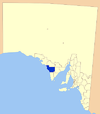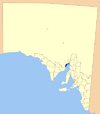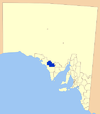LGAs sorted by region
The organisations, often called local government areas (LGAs) are constituted and managed in accordance with the Local Government Act 1999 (South Australia). They are grouped below by region, as defined by the Local Government Association of South Australia. [2] Maralinga Tjarutja and Anangu Pitjantjatjara Yankunytjatjara aboriginal councils both located in the remote north of the state are by far the largest South Australian LGAs, both exceeding 100,000 km2. [3] Coorong District Council and Loxton Waikerie are the next largest LGAs. [3] The smallest LGAs are Walkerville and then Prospect, both occupying less than 10 km2 each. [3]
The area with the largest population growth was Playford in Adealide's northern suburbs with a net increase of 2,847 people from June 2021 to June 2022. [3] Port Pirie had the largest net reduction in population of 106. [3] The fastest growth of an LGA in South Australia was in Adelaide Plains at 4.9 percent. [3] Coober Pedy was the fastest shrinking LGA, at -3.0 percent. [3]
Metropolitan Adelaide
This group of areas are found around Metropolitan Adelaide along a 70 km stretch of the Gulf St Vincent coast and up to 50 km inland.
| Local government area | Council seat | Year est. | Land area | Population [3] | Notes | Map | |||
|---|---|---|---|---|---|---|---|---|---|
| km2 | sq mi | Density (2022) [3] | 2021 | 2022 | |||||
| City of Adelaide | Adelaide | 1840 | 16 | 6 | 1677 | 25,551 | 26,120 | Capital city of South Australia 1840 Established as Adelaide Corporation 1843 Managed by the Colonial government, and then a commission 1852 Re-established 1919 Office of Mayor raised to Lord Mayor |  |
| Adelaide Hills Council | Woodside | 1997 | 795 | 307 | 52 | 41,250 | 41,448 | Amalgamation of District Councils of East Torrens, Gumeracha, Onkaparinga and Stirling |  |
| City of Burnside | Tusmore | 1856 | 28 | 11 | 1,697 | 46,444 | 46,692 | 1856 gazetted as District Council of Burnside 1935 became the Municipality of Burnside 1943 proclaimed the City of Burnside |  |
| City of Campbelltown | Rostrevor | 1854 | 24 | 9 | 2,301 | 55,475 | 56,013 | 1854 established as the District Council of Payneham 1867 District Council of Stepney (later itself called Payneham) seceded 1868 renamed to District Council of Campbelltown 1946 became the Town of Campbelltown 1960 proclaimed the City of Campbelltown |  |
| City of Charles Sturt | Woodville | 1997 | 55 | 21 | 2,280 | 123,146 | 124,906 | Amalgamation of City of Hindmarsh Woodville and the City of Henley and Grange |  |
| Town of Gawler | Gawler | 1857 | 41 | 16 | 635 | 25,304 | 26,123 | Established as the Corporation of the Town of Gawler in 1857 following resident dissatisfaction at being governed by three different district councils |  |
| City of Holdfast Bay | Brighton | 1997 | 14 | 5 | 2,768 | 37,868 | 38,061 | Amalgamation of Glenelg and Brighton city councils |  |
| City of Marion | Sturt | 1853 | 56 | 22 | 1,737 | 95,650 | 96,658 | 1853 established as the District Council of Brighton 1886 renamed to the District Council of Marion 1944 gazetted as the municipality, City of Marion |  |
| City of Mitcham | Torrens Park | 1853 | 76 | 29 | 905 | 68,180 | 68,403 | First LGA formally founded after the City of Adelaide |  |
| City of Norwood Payneham & St Peters | Norwood | 1997 | 15 | 6 | 2,516 | 37,850 | 38,001 | Amalgamation of the City of Kensington and Norwood, the City of Payneham and the Town of St Peters. |  |
| City of Onkaparinga | Noarlunga Centre | 1997 | 518 | 200 | 345 | 176,628 | 178,546 | Amalgamation of Cities of Happy Valley and Noarlunga with part of the District Council of Willunga |  |
| City of Playford | Elizabeth | 1997 | 345 | 133 | 300 | 100,573 | 103,420 | Amalgamation of the cities of Elizabeth and Munno Para |  |
| City of Port Adelaide Enfield | Port Adelaide | 1997 | 92 | 36 | 1,480 | 134,202 | 135,844 | Amalgamation of the cities of Port Adelaide and Enfield |  |
| City of Prospect | Prospect | 1872 | 8 | 3 | 2,919 | 22,497 | 22,741 | Separated from District Council of Yatala South |  |
| City of Salisbury | Salisbury | 1933 | 160 | 62 | 926 | 147,602 | 148,003 | Amalgamation of District Council of Yatala North and large part of District Council of Munno Para West |  |
| City of Tea Tree Gully | Modbury | 1858 | 95 | 37 | 1,078 | 102,067 | 102,666 | 1858 established by separation from District Council of Highercombe 1935 reunited with Highercombe under current name |  |
| City of Unley | Unley | 1871 | 14 | 5 | 2,739 | 39,082 | 39,085 | Separated from District Council of Mitcham as the Corporate Town of Unley |  |
| Town of Walkerville | Gilberton | 1855 | 4 | 2 | 2,317 | 8,091 | 8,179 | Separated from District Council of Yatala |  |
| City of West Torrens | Hilton | 1856 | 37 | 14 | 1,702 | 62,469 | 63,105 | 1856 established as the District Council of West Torrens 1944 became a municipal corporation, the Corporate Town of West Torrens 1950 gained city status as the City of West Torrens 1997 annexed the Town of Thebarton |  |
Regional South Australia
Eyre Peninsula
| Local government area | Council seat | Year est. | Land area | Population [3] | Notes | Map | |||
|---|---|---|---|---|---|---|---|---|---|
| km2 | sq mi | Density (2022) [3] | 2021 | 2022 | |||||
| District Council of Ceduna | Ceduna | 1896 | 5,427 | 2,095 | 0.7 | 3,651 | 3,650 |  | |
| District Council of Cleve | Cleve | 1911 | 4,507 | 1,740 | 0.4 | 1,776 | 1,765 | Separated from Franklin Harbour |  |
| District Council of Elliston | Elliston | 1887 | 6,500 | 2,510 | 0.2 | 1,038 | 1,037 | Boundary changes in 1989 |  |
| District Council of Franklin Harbour | Cowell | 1888 | 3,583 | 1,383 | 0.5 | 1,323 | 1,323 |  | |
| District Council of Kimba | Kimba | 1924 | 3,986 | 1,539 | 0.2 | 1,053 | 1,057 |  | |
| District Council of Lower Eyre Peninsula | Cummins | 1921 | 4,771 | 1,842 | 1.3 | 6,060 | 6,100 | Part of District Council of Port Lincoln (proclaimed 1880). District Council of Tumby Bay separated in 1906. Corporation of Port Lincoln separated in 1921. Remainder named District Council of Lincoln. Renamed Lower Eyre Peninsula in 1988. |  |
| City of Port Augusta | Port Augusta | 1964 | 1,153 | 445 | 12.5 | 14,453 | 14,456 |  | |
| City of Port Lincoln | Port Lincoln | 1921 | 30 | 12 | 492.2 | 14,880 | 14,947 | Separated from District Council of Port Lincoln in 1921. Proclaimed a city in 1971. |  |
| District Council of Streaky Bay | Streaky Bay | 1887 | 6,232 | 2,406 | 0.4 | 2,241 | 2,254 |  | |
| District Council of Tumby Bay | Tumby Bay | 1906 | 2,616 | 1,010 | 1.1 | 2,875 | 2,889 | Separated from District Council of Port Lincoln |  |
| City of Whyalla | Whyalla | 1970 | 1,033 | 399 | 20.4 | 21,960 | 21,894 |  | |
| Wudinna District Council | Wudinna | 1925 | 5,394 | 2,083 | 0.2 | 1,163 | 1,164 | Established as the District Council of Minnipa. Later renamed as District Council of Le Hunte. Given present name in 2008. |  |
Central region
Southern and Hills region
| Local government area | Council seat | Year est. | Land area | Population [3] | Notes | Map | |||
|---|---|---|---|---|---|---|---|---|---|
| km2 | sq mi | Density (2022) [3] | 2021 | 2022 | |||||
| Alexandrina Council | Goolwa | 1997 | 1,827 | 705 | 16.3 | 29,257 | 29,780 | Amalgamation of the District Council of Strathalbyn, the District Council of Port Elliot and Goolwa, and a portion of the District Council of Willunga. |  |
| Kangaroo Island Council | Kingscote | 1996 | 4,401 | 1,699 | 1.2 | 4,999 | 5,084 | Amalgamation of the District Council of Kingscote and the District Council of Dudley. |  |
| District Council of Mount Barker | Mount Barker | 1853 | 595 | 230 | 69.0 | 39,627 | 41,059 |  | |
| City of Victor Harbor | Victor Harbor | 1975 | 385 | 149 | 43.5 | 16,427 | 16,720 | Amalgamation of District Council of Encounter Bay and the Corporation of Victor Harbor in 1975. Formerly a district council, became a city in 2000. | |
| District Council of Yankalilla | Yankalilla | 1854 | 751 | 290 | 8.0 | 5,928 | 5,998 |  | |
Murray Mallee region
| Local government area | Council seat | Year est. | Land area | Population [3] | Notes | Map | |||
|---|---|---|---|---|---|---|---|---|---|
| km2 | sq mi | Density (2022) [3] | 2021 | 2022 | |||||
| Berri Barmera Council | Berri | 1996 | 476 | 184 | 22.5 | 10,747 | 10,713 | Amalgamation of district councils of Barmera and Berri. |  |
| Coorong District Council | Meningie | 1995 | 8,833 | 3,410 | 0.6 | 5,599 | 5,569 | Amalgamation of District Council of Coonalpyn Downs, Peake District Council and Meningie District Council. |  |
| District Council of Karoonda East Murray | Karoonda | 1979 | 4,416 | 1,705 | 0.2 | 1,025 | 1,028 | Amalgamation of District Council of Karoonda and District Council of East Murray. |  |
| District Council of Loxton Waikerie | Loxton | 1997 | 7,764 | 2,998 | 1.5 | 11,922 | 11,928 | Amalgamation of district councils of Loxton, Waikerie and Browns Well. |  |
| Mid Murray Council | Mannum | 1997 | 6,272 | 2,422 | 1.5 | 9,355 | 9,415 | Amalgamation of district councils of Mannum, Morgan, Ridley-Truro and part of the District Council of Mount Pleasant. |  |
| Rural City of Murray Bridge | Murray Bridge | 1977 | 1,832 | 707 | 12.3 | 22,348 | 22,554 |  | |
| Renmark Paringa Council | Renmark | 1996 | 916 | 354 | 11.0 | 10,009 | 10,044 | Amalgamation of Town of Renmark and the District Council of Paringa. |  |
| Southern Mallee District Council | Pinnaroo | 1997 | 5,702 | 2,202 | 0.4 | 2,029 | 2,013 |  | |
Southeast region
| Local government area | Council seat | Year est. | Land area | Population [3] | Notes | Map | |||
|---|---|---|---|---|---|---|---|---|---|
| km2 | sq mi | Density (2022) [3] | 2021 | 2022 | |||||
| District Council of Grant | Mount Gambier | 1996 | 1,898 | 733 | 4.7 | 8,862 | 8,925 | Amalgamation of District Councils of Mount Gambier and Port MacDonnell. |  |
| Kingston District Council | Kingston SE | 1873 | 3,340 | 1,290 | 0.7 | 2,375 | 2,389 | Renamed from Lacepede District Council in 2000. |  |
| City of Mount Gambier | Mount Gambier | 1876 | 34 | 13 | 819.4 | 27,642 | 27,771 |  | |
| Naracoorte Lucindale Council | Naracoorte | 1993 | 4,520 | 1,745 | 2.0 | 8,896 | 8,928 | Amalgamation of District Council of Naracoorte, District Council of Lucindale and the Corporate Township of Naracoorte. |  |
| District Council of Robe | Robe | 1869 | 1,092 | 422 | 1.5 | 1,568 | 1,583 |  | |
| Tatiara District Council | Bordertown | 1876 | 6,527 | 2,520 | 1.1 | 7,072 | 7,040 |  | |
| Wattle Range Council | Millicent | 1997 | 3,926 | 1,516 | 3.1 | 12,127 | 12,163 | Amalgamation of district councils of Beachport, Millicent and Penola. |  |
Outback
| Local government area | Council seat | Year est. | Land area | Population [3] | Notes | Map | |||
|---|---|---|---|---|---|---|---|---|---|
| km2 | sq mi | Density (2022) [3] | 2021 | 2022 | |||||
| Aṉangu Pitjantjatjara Yankunytjatjara | Umuwa | 1981 | 102,353 | 39,519 | 0.0 | 2,554 | 2,595 |  | |
| District Council of Coober Pedy | Coober Pedy | 1987 | 78 | 30 | 20.3 | 1,624 | 1,576 |  | |
| Maralinga Tjarutja | Ceduna | 2006 | 102,704 | 39,654 | 0.0 | 102 | 102 |  | |
| Roxby Council | Roxby Downs | 1982 | 111 | 43 | 37.2 | 4,115 | 4,105 |  | |

































